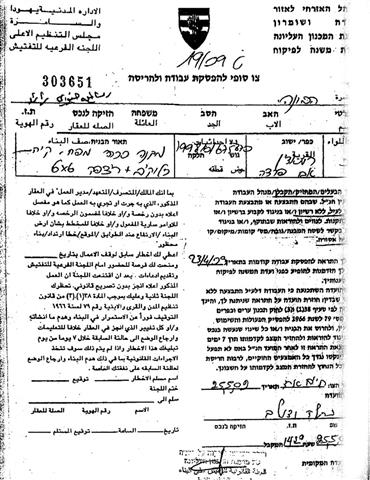At the beginning of June, 2009, an Israeli army force arrived at the Bedouin village of Arab ar Ramadin Al Janubi (south Ramadin) in Qalqiliya district. The army was accompanied with teams from the Planning and Construction Department at the so-called Israeli civil administration in the West Bank who began to distribute halt of construction notifications to owners of five residential and animal barracks under the pretext of un-licensing. The notifications were dated April, 2009. The following table gives details about these structures:
|
No. |
Owner's name |
No. of occupants |
Area in M2 |
Type |
|
1 |
Kamel Salameh Sha'ur |
7 |
100 |
House |
|
2 |
The village's reception tent |
00 |
15 |
Reception tent |
|
3 |
Yunis Jaber Sha'ur |
00 |
36 |
Animal barrack |
|
4 |
Kassab Bajis Sha'ur |
00 |
36 |
Animal barrack |
|
5 |
Maher Salim Sha'ur |
00 |
24 |
Animal barrack |
|
Total |
|
211 |
|
|
Source: LRC field work
(Photos 1,2,3 & 4: Copies of the halt of construction notifications)
It is worth saying that the notifications mention the 25 of May, 2009, as deadlines to owners to apply for building permissions which means that the dead line time had expired before the date of the distribution of the notifications, a status often repeated and shows the Israeli non respect and recklessness towards Palestinian cases.
During the last five years the number of residential and agricultural structures notified for demolition or halt of construction reached 20 for allegedly located in Zone C ( according to Olso declaration, zone C remains under full Israeli security and civic affairs).
Historical background
Arab ar Ramadin Al Janubi became refugees during the first Arab-Israeli war of 1948. They were dismissed out of their land in Bir Sheva' and Negev areas and re-settled in Hebron and Qalqiliya districts. Those who moved to Qalqiliay lived in two places: the first north of the city of Qalqiliya and west of Jayyus village, and the second, south of the city of Qalqiliya and west of Alfe Menashe colony. They bought tabooed land from the near by village of Habla and built on it.
( Photo 5: a general view of Arab ar Ramadin Al Janubi hamlet )
Wall impacts
Since the building of the Segregation Wall in 2002 the five hamlets of Arab ar Ramadin Al Janubi which has the population of 250 people and land area of 15 dunums, Arab Abu Farda ( 150 people), ad Dab'a ( 280 people), Wadi ar Rasha ( 180 people) and Ras Tyra ( 410 people) were all put in one ghetto inside the Wall so as to annex the colony of Alfe Menahse ( see attached map).
(Map 1: location of Arab Ar Ramadin Al Janubi )
Two Wall gates are controlling the movement of the aforementioned five hamlets, the first of which is number 109 located at the distance of three km from ar Ramadin Al Janubi and links the colony of Alfe Menashe with the Israeli proper, and, the second, is Wall gate number 1351 which links the five ghettoized hamlets with the village of Ras atiya which is outside the Wall. All the ghetto's citizens are obliged to obtain special passing permits from the Israeli military to pass through the two Wall gates which only open from 6 AM to 6 PM.
On 29 of August, 2007, the Israeli supreme court ruled that the Wall path should be revised and the three hamlets of ad Dab'a, Wadi ar Rasha and Ras Tyra be out of it. As regards the two remaining communities of Arab ar Ramadin Al Janubi and Arab Abu Farda the court's decision confirmed their right to stay in their land or leaved voluntarily. However, in June, 2008 the so-called Israeli civil administration in the West Bank offered the two communities the choice of re-allocation out side the Wall and when they refused they were threatened with forced eviction because their presence in that place is undesired.
Related case studies
1. Wall re-routing: a new tool for the destruction, separation and confiscation of more Palestinian land, Qalqiliya district, June, 2006.
2. Ghettoized Palestinian villages suffer further movement restrictions – Qalqiliya Governorate, December, 2006.
Prepared by:




















